
Start-up Procedure
To ensure proper operation of each unit, qualified per-
sonnel should perform the start-up and complete the
checklist below and the start-up form in
for
permanent record. A completed checklist will provide
valuable information for personnel performing future
maintenance.
All units are factory run tested. Blowers, heat wheel and
compressors (if equipped) are set up to run correct when
power is connected. If any one blower is running back-
wards or compressor is making loud noises disconnect
power and switch two leads (on three-phase power) to
ensure proper rotation and avoid damage.
If units are equipped with compressors power must be
turned on for 24 hours prior to a call for cooling, for the
compressor crank case heaters to be energizing to pre-
vent possible damage.
The BacStat II interface module (if equipped with DDC
control package and mounted remotely) may be tem-
porarily connected at the unit for checkout. Ensure it is
connected to the Net 2 contacts otherwise it will not give
readings.
1. Before proceeding complete the pre start-up
checklist.
2. Check that all access panels or doors are closed.
3. Turn the main disconnect to the ‘On’ position.
4. Set the timer, selector switch or BMS contact to the
ventilation control scheduling mode selected and
check operation according to sequence. Only one of
the following modes selected can have their contacts
closed or jumped.
a. Occupied ventilation (Ov): With the occupancy
contact closed or a jumper placed across ter-
minals, heat wheel starts (not in free cooling),
defrost recirculation damper closes (if equipped),
outside and exhaust air dampers open fully,
the supply blower starts and after exhaust air
damper opens fully, the exhaust blower starts.
b. Unoccupied recirculation (Ur): With the unoc-
cupied recirculation contact closed or a jumper
placed across terminals, heat wheel stops, de-
frost recirculation damper opens, outside and
exhaust air dampers (if equipped) begin to close
and supply blower starts.
c. Occupied recirculation (Or) (DDC control pack-
age only): With the occupied recirculation con-
tact closed or a jumper placed across terminals,
heat wheel starts (not in free cooling), defrost
recirculation damper closes (if equipped), outside
air damper (if equipped) opens. After outside air
damper opens supply blower starts, exhaust air
damper (if equipped) opens; after exhaust air
damper opens, exhaust blower starts, occupied
recirculation damper opens, outside and exhaust
air dampers modulate to the damper minimum
setpoints.
5. Check that dampers are operating properly.
6. Check that blowers and enthalpy wheel are rotating
in the correct direction.
7. For occupied recirculation scheduling mode the out-
side air and exhaust air dampers must be adjusted
during start-up to achieve the required outside and
exhaust air volumes. See
ther information.
8. Re-check the voltage at the disconnect switch
against the nameplate and against phase-to-phase
readings on three-phase with all blowers operating.
If the voltage is not within 10% of rated or 2% of
phase-to-phase have the condition corrected before
continuing start-up.
9. Check amperage draw to each motor on each phase
against motor nameplate FLA. If significantly different,
check ductwork static and/or take corrective action.
10. Before activating the compressor on WSHP units,
are water shut-off valves open and is water circulat-
ing through the water-to-refrigerant heat exchanger.
11. Enable cooling and check if the sound of the com-
pressor is normal or if there is excessive vibration.
12. Check all field and factory refrigerant and water pip-
ing connections for leaks and correct.
13. On units with gas-fired furnace module, check that
the manual reset high limit switch is closed (press
reset button) and check supply air proving interlock
switch setting to ensure minimum supply airflow prior
to burner operation. Set the switch to open below
the minimum supply airflow on the furnace rating
plate.
14. Enable heating options, see start-up and check out
instructions in
for electric coil and complete.
15. Check the operation of the control options provided
on the unit. A functional description is provided
below and in the VHC-36, -42 and -50 DDC Control
Package Manual.
16. Check the setpoints on the DDC Points Reference;
adjust and record changes as required.
17. When unit has achieved steady state take measure-
ments and complete the readings section of the
Start-up Form in
to verify all components are functioning properly and
send copy of the Start-up Form to Venmar CES to
validate warranty. Maintain a copy of the report at
the unit for future reference.
IMPORTANT
A completed copy must be sent back to the factory for
warranty validation and for factory assistance.
VCES-VHC-IOM-1F – VHC-36, -42 & -50
15
















































